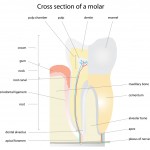
Partial of complete pulpotomy is increasing being used as a treatment approach in permanent teeth. Ideally pulpotomy dressing materials should be bio-compatible, promote hard tissue formation, and exhibit antimicrobial activity without being toxic to the remaining pulp tissue. Calcium hydroxide pastes, calcium-enriched mixture (CEM), mineral trioxide aggregate (MTA) and other calcium-silicate-based cements are some of the bioactive cements used in permanent teeth.
The aim of this review was to evaluate the success rate of pulpotomies on permanent teeth using ProRoot MTA, compared to calcium hydroxide or other bioceramic cements.
Methods
A protocol for the review was registered in the PROSPERO database. Searches were conducted in the Cochrane Library, Embase, PubMed, Science Direct, Scopus, Web of Science and Open Grey databases. Randomised controlled trials (RCTs) in permanent teeth comparing ProRoot MTA against calcium hydroxide or other bioceramic materials were considered. Two reviewers independently selected studies and extracted data with disputes being resolved by a third reviewer. Study quality was assessed using the Cochrane Risk of Bias 2 (RoB 2) tool. The primary outcome was success rate expressed as risk ratios (RR) with 95% confidence intervals (CIs). The certainty of evidence was assessed using the Grading of Recommendations, Assessment, Development and Evaluation (GRADE) approach.
Results
- 16 papers reporting from 15 studies were included.
- 6 studies were considered to have a low risk of bias and 10 a high risk.
- Sample sizes ranged from 30 to 413 teeth with follow up periods of 1 to 78 months.
- Overall success rate for pulpotomy was 92% at one year.
- Meta-analyses were conducted for the most common follow up time of 12 months. Findings showed the success rate of pulpotomy in permanent teeth was significantly higher when using ProRoot MTA compared to calcium hydroxide, but no differences were seen between ProRoot MTA and calcium-enriched mixture (CEM) or ProRoot MTA and Biodentine (see table below).
| Comparison | No. of studies | Odds ratio (95%CI) |
| ProRoot MTA v calcium hydroxide | 6 | 3.50 (1.53 to 8.02) |
| ProRoot MTA v CEM | 2 | 1.32 (0.69 to 2.51) |
| ProRoot MTA v Biodentine | 3 | 1.04 (0.37 to 2.95) |
- No significant differences in the success rate of pulpotomy were seen between mature and immature teeth, patients aged between 6–13 years and 14–60 years, teeth with reversible and irreversible pulpitis, partial and full pulpotomy, and cases where a temporary seal was performed or not or when the final restorative material was amalgam or composite resin (see table below).
| Comparison | Odds ratio (95%CI) |
| Mature vs. immature teeth | 0.85 (0.55 to 1.31) |
| Between 6–13 years and 14–60 years | 1.48 (0.91 to 2.41) |
| Reversible vs. irreversible pulpitis | 1.39 (0.72 to 2.69) |
| Partial vs. full pulpotomy | 1.25 (0.80 to 1.96) |
| Temporary seal performed or not | 1.04 (0.62 to 1.77) |
| Amalgam or composite resin as final restoration | 0.94 (0.49 to 1.82) |
- The overall certainty of evidence was assessed as low.
Conclusions
The authors concluded: –
This systematic review and meta-analysis demonstrate that pulpotomy is a highly effective treatment for managing permanent teeth. The results indicate that the success rate of pulpotomy using ProRoot MTA is significantly higher than when using calcium hydroxide. However, the certainty of evidence supporting these findings is low, and there is a need for well-designed RCTs to assess the long-term outcomes of pulpotomy using newer bioceramic materials.
Comments
The authors registered their protocol with PROSPERO and searched a good range of databases and only considered studies using an RCT design. Ten of the included studies were considered to be at high risk of bias with the GRADE level of certainty of the evidence assessed as low which should be taken into consideration when interpreting the findings. The authors report the results at 12 months showing good overall success rates for pulpotomy at 92% with meta-analysis indicating a better outcome for ProRoot MTA however this is based on 6 studies and the confidence intervals are wide. The authors note that many studies lacked information of pulp status and the reason for choice of pulpotomy type or other factors that might influence pulpotomy outcome. A majority of the included studies used cold sensibility tests to assess outcomes which could potentially underestimate outcomes. Well designed and reported RCTs of appropriate size and with longer follow up periods using standardises assessment and common outcomes assessment would be helpful to provide better evidence of the long-term efficacy new bioactive materials for pulpotomy.
Links
Primary Paper
Silva EJNL, Pinto KP, Belladonna FG, Ferreira CMA, Versiani MA, De-Deus G. Success rate of permanent teeth pulpotomy using bioactive materials: A systematic review and meta-analysis of randomized clinical trials. Int Endod J. 2023 May 30. doi: 10.1111/iej.13939. Epub ahead of print. PMID: 37254176.
Other references
Dental Elf – 26th Apr 2023
Dental Elf – 28th Oct 2019
Dental Elf – 22nd Jul 2019
Dental Elf – 10th Jul 2019
